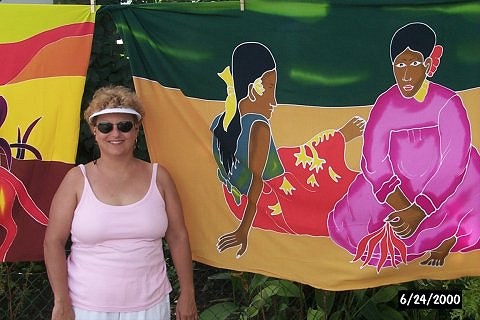Ever since I got into the trick of accessing JSTOR, I've been coming across worthy academic papers on some very strange subjects.
For example, I came upon this:
The Community Function of Tahitian Male Transvestitism: A HypothesisRobert I. Levy Anthropological Quarterly, Vol. 44, No. 1 (Jan., 1971), pp. 12-21
Here was an aspect of Austronesian culture that had often puzzled me here in the Philippines, but I didn't realise that exactly the same occurs in Tahiti, 6000 miles away from here.
Even the local Surigaonon word for them,
bayut, is recognisably closely related to the Tahitian
mahu.It seems that Tahitian society licenses, quite strictly, occasional and very blatant transvestism every bit as much as the Philippines society does (and, of course, so do other South-East Asians, like the Thais, with their
katoeys).
Because the practice is limited and licensed, it's perfectly acceptable. There's no queer-bashing here.
There tends to be one mahu in each village, the belief of villagers being that "it is natural" or "God so arranged it" that there should be at least one and no more than one. Tahitian sexual identity is undifferentiated in its contrast of maleness and femaleness in relation to Western expectations.
It is proposed that the presence of the mahu helps stabilize this identity for men by providing a highly visible and exclusively limited contrast, implying for other men in the village, "I am a man because I am not a mahu.Levy studied village life in Piri village on an island, Huahine, 100 miles from Papeete, the capital of Tahiti.
In 1961 there was a sixteen year old boy in Piri, who was referred to sometimes by his personal name, sometimes as "the mahu." Although there were photographs of him proudly displayed in his foster mother's house showing him in dancing costume, complete with brassiere, he wore male clothes ordinarily, favoring however the neutral sarong-like pareu, worn by both sexes, rather than the Western style trousers now worn frequently by men in the village. His speech and manner were somewhat feminine - resembling feminine style without exaggerating or mocking it. His feminine role-taking was made apparent to the villagers primarily because he performed women's household activities, and because his associations were of feminine type. He cleaned the house, took care of babies, plaited coconut palm leaves into thatching sections, and made decorative patch work quilts. He associated with the adolescent girls in the village as a
peer, walking arm-in-am with them, gossiping and visiting with them.
There were two other men in Piri who had feminine mannerisms. It was sometimes said about them that they were mahu-like, but they were not said to be mahus. They had wives and children, and performed men's tasks in the village. There was also a man in his twenties who had been a mahu in Piri, when the present one was a child. According to the village reports he had given up being a mahu, had gone to Papeete to work, and was now living as an "ordinary man." Mahus were not defined by effeminate
behavior alone; they also had to fulfill some aspects of a woman's village role, a role they could give up to become ex-mahus.
The very idea of overt everyday transvestism shocked me at first. When I lived in Palawan, on the western side of the Philippines, the city council held a Drag Queen Festival, with transvestites coming from all over the country. I considered it just a bit of vulgar commercialism put together for tourists, and the local mob.
When I came to Siargao Island, I found the same situation, when my own small parish held a Drag Contest.
It was then that I realised, seeing the wholesome family audience, that the whole idea of
mahu/bayut was a sort of institutionalised gender-joke. The audience were cheering their very own
bayut as much as they could, and jeering at out-of-towners. Their very own
bayut won the 'contest' of course.
And these guys
are gals. Here are two of our very own local lovelies:

This is Jennifer, chief cook to my odious neighbour, Andreas, of Patrick's resort. She/he is a bit snooty, and certainly has the best-looking legs hereabouts. But 'she' comes from Katangnan, near Cloud 9, so she didn't have a hope in this contest, held at 'Tattoo', our local jungle disco, in Purok 3.

And this is Eyay, aka Nelson. I've known him since he was 12, and only showing slight tendencies towards being a little too eager to volunteer to help around the house.
Regrettably, he suffers from a very visible case of testosterone-induced facial acne, and was never endowed with any physical grace or beauty. He, though, being from Purok 3, was the local audience's favourite jester. He, if I needed to show that homosexuals are made, not born, is the perfect example. He desperately needs peer approval, and this way he has a chance to get it.
Just so you don't get me too wrong, here is a picture of my two good friends,Adie and Diding:
I've known them since they were 17, and employed them for several years as beadsmiths. Now they run (very well) the bamboo 'Nine Bar' just 100 metres up the road from me, and it's a great place.
Next time you're here, we'll have a drink or two there, and relax to some cool old-fashioned music.
But I'm involved in a race against time. I'm waiting for their combined ages to meet mine, when I'll definitely commit bigamy, and marry them both.
Roll on, 2027!













